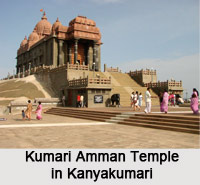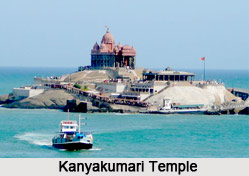 The Kanyakumari Temple is a small temple dedicated to goddess Kanyakumari. It is located on the seashore of Kanyakumari. The temple is ancient one and is mentioned in the Ramayana, Mahabharata, and the Sangam works, Manimekalai and Puranaanooru. The image of Kanyakumari was installed and worshipped by Parasurama.
The Kanyakumari Temple is a small temple dedicated to goddess Kanyakumari. It is located on the seashore of Kanyakumari. The temple is ancient one and is mentioned in the Ramayana, Mahabharata, and the Sangam works, Manimekalai and Puranaanooru. The image of Kanyakumari was installed and worshipped by Parasurama.
Legend: Demon Baanaasuran had wreaked havoc on the inhabitants, when Mahavishnu requested the gods and the humans to create an energy Paraasakthi to vanquish the demon. Answering the prayers Shakti appeared as a young girl at Kanyakumari and commenced a penance with the desire of marrying Shiva at Suchindram. Narada fixed the time as midnight for the wedding. When Shiva`s procession reached Vazhukkumpaarai, a rooster crowed, heralding daybreak, Shiva returned to Suchindram. The disappointed goddess chose to spend her life in Kanyakumari as a virgin. The food prepared for the wedding went waste and turned into sand, which can be seen on the southern shores.
The demon Banaasuran hearing of Shakti`s story proceeded to Kanyakumari to win her hand in marriage, which led to a fierce battle in which he was slain.
Temple: The black stone image in the sanctum wears an enchanting garland. She also wears a glittering nose ring visible from a distance. The light emanating from the nose ring used to misguide the ships and many crashed on the rocky coast. The door was built facing the east and is now opened only five times a year. There are shrines dedicated to Vijayasundari and Balasundari, friends and playmates of the Goddess. There are 11 theerthams associated with the temple. The confluence of the seas, at the southern tip of the subcontinent has been held sacred for centuries. The eastern door is opened also on new moon days in the months of Thai, Aadi (Capricorn and Cancer), during Navaratri and in the month of Kaartikai.
Festivals: The Vaisakha festival is celebrated in the Tamil month of Vaikasi where an image of the goddess is taken around town in procession on various mounts. The car festival, the Aaraatu (when the eastern door to the shrine is opened) and the float festival here are of significance. The Kalabham (sandal) festival is held in the month of Aadi when the image is covered with sandal paste, and on the 13th day, the last Friday of the month, the image is covered with umpteen flowers. The image of the deity is held in worship at the Navaratri mandapam throughout Navaratri, and processions mark the celebrations. Destruction of Baanasuran is enacted on Vijaya Dasami.





















